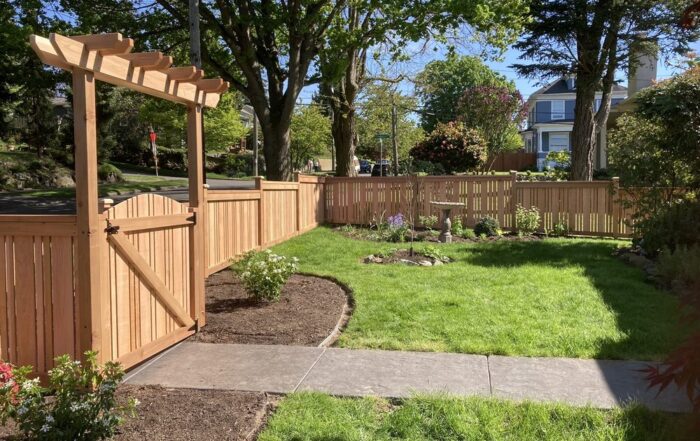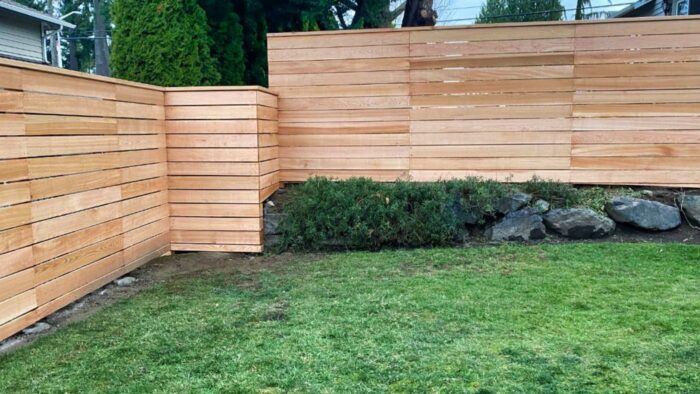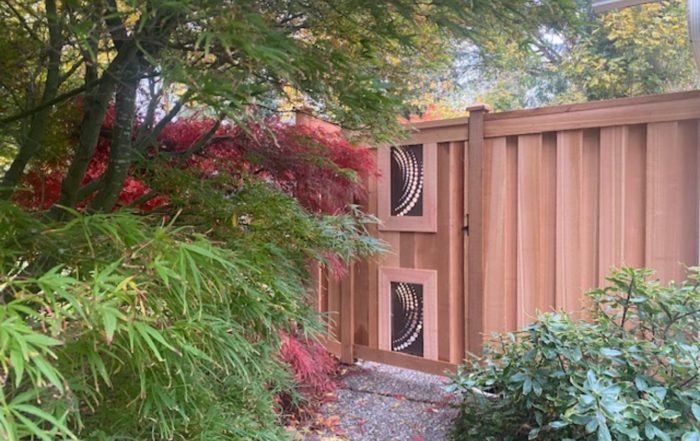Cedar Fence,Chain Link Fence,FAQs,Fence Design,Fence Tips,Materials,Metal Fence,Pets,Safety,Vinyl Fence
When it comes to our furry companions, their safety and well-being are of utmost importance. As responsible pet owners, we strive to create a secure environment for our dogs, ensuring they can roam freely without encountering any harm...
When it comes to our furry companions, their safety and well-being are of utmost importance. As responsible pet owners, we strive to create a secure environment for our dogs, ensuring they can roam freely without encountering any harm. One vital aspect of providing a safe space for our canine friends is selecting the right fence. However, with various fence options available in the market, it can be challenging to determine which one suits your dog’s specific needs.
In this comprehensive guide, we will explore how dog behavior influences your fence selection, enabling you to make an informed decision that aligns with your pup’s unique requirements.
Being a Good Neighbor: Building the Right Fence
A well-designed fence for your dog not only keeps them safe but also helps you become a better neighbor. By considering your dog’s needs and behavior when selecting a fence, you can prevent conflicts and foster a positive relationship with those living around you.
According to a survey by FindLaw.com, four in ten Americans have experienced neighbor disputes. Pet-related issues often contribute to these conflicts. However, by choosing the right fence, you can avoid potential problems and promote a harmonious neighborhood.
Here’s how building the right fence can make you a better neighbor:
- Noise Control: Selecting a fence that provides visual barriers, like a solid privacy fence, can help minimize your dog’s barking and prevent unnecessary noise disturbances for your neighbors.
- Containment and Safety: A well-built fence ensures your dog stays within your property, preventing them from roaming freely and potentially causing issues with neighboring properties.
- Respect for Boundaries: Installing a fence that clearly marks your property boundaries helps your neighbors understand where your dog should and shouldn’t be, avoiding any misunderstandings or conflicts.
- Enhanced Security: A sturdy fence acts as a deterrent, keeping unwanted intruders away and providing a sense of security for both you and your neighbors.
By investing in the right fence for your dog, you demonstrate responsible pet ownership and contribute to a peaceful living environment for everyone.
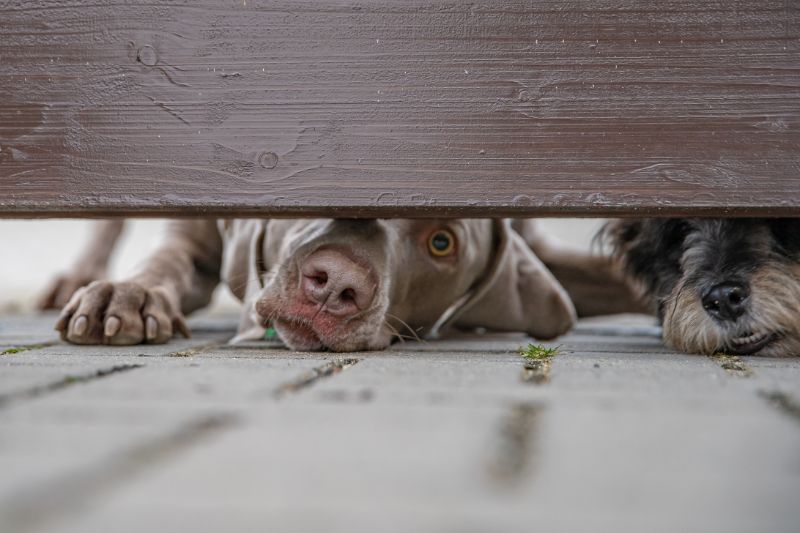
Canine Instincts: Understanding Your Dog’s Behavior
Dogs are driven by a variety of instincts, inherited from their wild ancestors. These inborn tendencies, like territoriality, prey drive, and pack mentality, all have implications for your fence selection. Dogs with a high prey drive may require more secure, higher fences to keep them from pursuing squirrels or cats that wander into their line of sight. Likewise, territorial dogs might benefit from a privacy fence that limits their view of passersby and potential “intruders”.
The Effects of Training and Socialization
Training and socialization play a significant role in shaping your dog’s behavior, and consequently, your fence selection. Dogs that are well-socialized and well-trained are less likely to exhibit problematic behaviors, like excessive barking, digging, or attempts to escape.
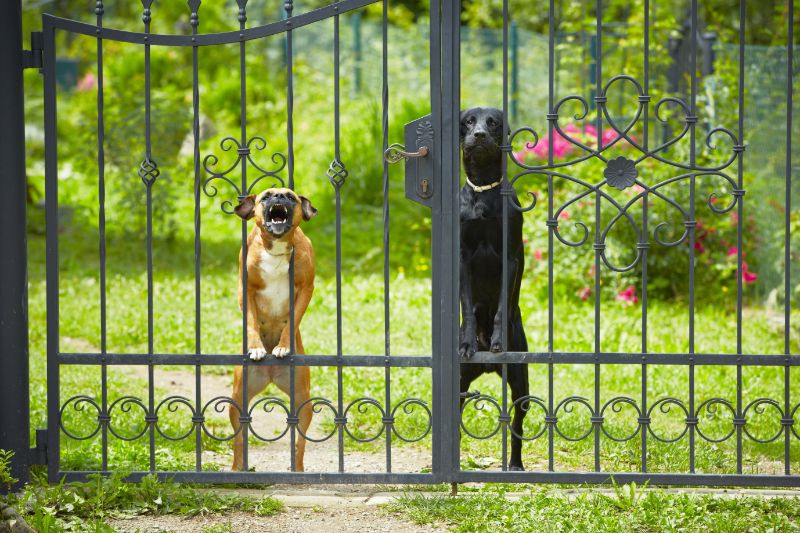
Tailoring Your Fence to Your Dog’s Behavior
Understanding your dog’s behavior is crucial when selecting an appropriate fence. Dogs exhibit different temperaments and tendencies that can significantly impact the effectiveness of various fence types. Let’s delve into the various dog behaviors and how they influence your fence selection.
1. The Escape Artist: A Dog Who Loves Adventure
We all have that one dog who’s a born adventurer, always seeking thrills and excitement. These curious canines may try to make a daring escape from your yard whenever they get the chance. If your furry friend falls into this category, it’s crucial to choose a fence that can contain their insatiable curiosity.
Examples of Dog Breeds That Might Exhibit the Escape Artist Behavior
- Siberian Husky
- Australian Shepherd
- Australian Cattle Dog
- Jack Russell Terrier
- Border Collie
- Beagle
- Dalmatian
- Shetland Sheepdog
- Vizsla
- Alaskan Malamute
- Weimaraner
- Belgian Tervuren
- Basenji
Recommended Fence Options:
- Solid Wood Fence: A solid wood fence provides privacy and creates a physical barrier, preventing your dog from seeing potential escape routes.
- Vinyl Privacy Fence: Similar to a solid wood fence, vinyl privacy fences offer an obstruction-free surface, reducing your dog’s temptation to venture outside.
- Chain Link Fence with Privacy Slats: Adding privacy slats to a chain link fence can limit visibility, minimizing the chances of your dog attempting to escape.
2. The Social Butterfly: A Dog Who Loves to Interact
If your dog is a social butterfly who loves to interact with people or other animals, it’s crucial to consider their behavior when selecting a fence. Dogs with a friendly nature may become easily excited and attempt to greet passersby, which can lead to safety concerns.
Examples of Dog Breeds That Might Exhibit Social Butterfly Behavior:
- Labrador Retriever
- Golden Retriever
- Beagle
- Boxer
- Bulldog
- Cavalier King Charles Spaniel
- Poodle
- Dalmatian
- Australian Shepherd
- Irish Setter
Recommended Fence Options:
- Decorative Metal Fence: A decorative metal fence not only enhances the aesthetic appeal of your yard but also provides a clear view of the surroundings, allowing your dog to observe and interact without the risk of escape.
- Picket Fence: A classic picket fence offers a balance between visibility and containment. It allows your dog to see outside while keeping them safely within the enclosed space.
- Split Rail Fence: This rustic-style fence provides a partially open view, giving your social dog the opportunity to interact while still maintaining a secure environment.
3. The Agile Jumper: A Dog With Impressive Leaping Skills
Certain breeds possess remarkable jumping abilities, enabling them to clear fences that would be a challenge for others. If you have a canine athlete capable of impressive leaps, it’s crucial to choose a fence that can deter their Houdini-like skills.
Examples of Dog Breeds That Might Exhibit Agile Jumper Behavior:
- Border Collie
- Australian Shepherd
- German Shepherd
- Belgian Malinois
- Siberian Husky
- Golden Retriever
- Labrador Retriever
- Boxer
- Bull Terrier
- Jack Russell Terrier
Recommended Fence Options:
- Privacy Fence with Topping: Install a privacy fence that includes additional features such as a coyote roller or a leaning extension. These modifications make it difficult for your agile jumper to gain leverage and escape.
- Invisible Electric Fence: Combine a traditional fence with an invisible electric fence system to create a dual barrier. This solution provides a psychological deterrent, discouraging your dog from attempting to jump over the physical fence.
4. The Curious Digger: A Dog With a Penchant for Excavation
Some dogs find joy in digging and exploring the world beneath the surface. If your furry friend falls into the curious digger category, it’s essential to choose a fence that can prevent their escape through the ground.
Examples of Dog Breeds with Curious Digging Behavior:
- Dachshund
- Beagle
- Siberian Husky
- Jack Russell Terrier
- Border Terrier
- Australian Terrier
- Cairn Terrier
- Miniature Schnauzer
- West Highland White Terrier
- Norfolk Terrier
Recommended Fence Options:
- Concrete Footer: Consider installing a concrete footer along the base of your fence. This barrier provides an effective deterrent, preventing your dog from digging their way to freedom.
- Buried Wire System: Utilize a buried wire system in combination with an electric fence collar. The wire emits a mild shock when your dog gets too close to the boundary, discouraging digging behavior.
5. Ability to Squeeze Through Small Spaces: Keeping the Little Adventurers Safe
If you have a puppy or a smaller breed that has a knack for squeezing through small spaces, it’s crucial to choose a fence that prevents their Houdini-like escapes. These little adventurers can be quite clever and may find their way out if given the opportunity.
Examples of Dog Breeds Prone to Squeezing Through Small Spaces:
- Chihuahua
- Dachshund
- Jack Russell Terrier
- Yorkshire Terrier
- Shih Tzu
- Pomeranian
- Cavalier King Charles Spaniel
- Maltese
- Miniature Pinscher
- Rat Terrier
Recommended Fence Options:
- Solid Panel Fence: Opting for a solid panel fence is a great solution for dogs that can squeeze through narrow gaps. These fences provide a seamless barrier without any openings or gaps, making it difficult for your furry friend to find an escape route. Solid panel fences offer a sturdy and secure enclosure, giving you peace of mind knowing that your dog is safely contained within your yard.
- Small-Mesh Chicken Wire Fence: Another suitable option for preventing small dogs or puppies from squeezing through is a fence with small-mesh chicken wire. This type of fence is designed with tightly woven wire mesh that effectively restricts the size of gaps. It acts as a protective barrier, preventing your little explorer from slipping through and venturing beyond the confines of your yard. Small-mesh chicken wire fences offer a combination of security and visibility, allowing your dog to enjoy the outdoors while ensuring their safety.
- PVC or Vinyl Fence with No Gaps: Consider a PVC or vinyl fence that is specifically designed without any gaps. These fences provide a solid and continuous surface without any openings, leaving no room for your pint-sized escape artist to squeeze through. PVC or vinyl fences are durable, low-maintenance, and can withstand the energetic antics of puppies and small breeds.
In addition to selecting the right fence, it’s essential to regularly inspect and maintain the integrity of the fence to ensure there are no potential escape points. Check for any loose panels, gaps, or areas where your dog might attempt to dig under the fence.
6. The Reactive Barker: A Dog With Heightened Sensitivity
Dogs with reactive behavior tend to bark excessively at stimuli such as other animals, loud noises, or even unfamiliar people. If your pup falls into this category, it’s crucial to choose a fence that limits their exposure to potential triggers, ensuring a peaceful and stress-free environment.
Examples of Dog Breeds with Reactive Behaviors:
- Shih Tzu
- Chihuahua
- Dachshund
- Pomeranian
- Yorkshire Terrier
- Miniature Schnauzer
- Beagle
- German Shepherd
- Border Collie
- Australian Shepherd
Recommended Fence Options:
- Solid Wood Fence with Soundproofing: A solid wood fence combined with soundproofing materials can significantly reduce noise transmission, providing a calming environment for your reactive barker.
- Privacy Fence with Visual Barriers: Opt for a privacy fence that includes visual barriers, such as lattice panels or plants. These additions block your dog’s line of sight, minimizing triggers and reducing the urge to bark.
- Noise-Canceling Devices: Consider using noise-canceling devices near the fence line to mitigate external sounds that may trigger reactive barking.
7. The Predator: Dealing with Dogs with Predatory Behavior or Chasing
If you have a dog with predatory behavior or a strong inclination to chase after anything that moves, it’s essential to choose a fence that can effectively manage and contain their instincts. These dogs may be driven by their innate prey drive, making it crucial to prioritize their safety while still allowing them to enjoy their outdoor space.
Examples of Dog Breeds with Predatory Behavior or Chasing Instincts:
- Border Collie
- Australian Shepherd
- Siberian Husky
- Greyhound
- Jack Russell Terrier
- Vizsla
- Weimaraner
- Afghan Hound
- Basenji
- Whippet
Recommended Fence Options:
- Solid Wood or Privacy Fence: Opting for a solid wood or privacy fence can be an excellent choice for dogs with predatory behavior. These types of fences provide a barrier that limits your dog’s visibility to external stimuli, reducing their temptation to chase after animals or objects passing by. The solid construction eliminates any potential gaps that might trigger their prey drive, ensuring their safety and preventing escapes.
- Chain-Link Fence with Privacy Slats: If you prefer a fence with a more open feel while still addressing your dog’s predatory behavior, a chain-link fence with privacy slats can be a suitable option. The chain-link provides durability and containment, while the privacy slats add an extra layer of visual obstruction. This combination helps minimize your dog’s exposure to external distractions, reducing their likelihood of engaging in chasing behaviors.
- Electric or Invisible Fence: For dogs with a strong prey drive, electric or invisible fences can offer an alternative solution. These fences work by utilizing an underground wire or wireless technology to create an invisible boundary. When your dog approaches the boundary, they receive a mild static correction through a specialized collar. This reinforcement helps deter them from chasing or crossing the designated area. However, it’s crucial to note that these fences should always be used in conjunction with proper training and supervision to ensure your dog’s safety and well-being.
8. Aggression Towards Strangers or Other Dogs: The Protector in Action
If you have a dog with a tendency to exhibit aggression or suspicion towards strangers or other dogs, it’s crucial to consider their behavior when choosing the right fence. Dogs with these tendencies require a secure and effective barrier that not only ensures their safety but also helps manage their reactions to external stimuli.
Examples of Dog Breeds with Aggression Towards Strangers or Other Dogs:
- German Shepherd
- Rottweiler
- Doberman Pinscher
- Bullmastiff
- Akita
- Chow Chow
- Belgian Malinois
- Cane Corso
- Staffordshire Bull Terrier
- Dalmatian
Recommended Fence Options:
- Solid Privacy Fence: Opting for a solid privacy fence is a wise choice for dogs with aggressive tendencies. These fences are designed to block the view from both sides, limiting your dog’s visibility of strangers or other dogs passing by. By reducing their visual access to potential triggers, such as unfamiliar faces or unfamiliar canines, a solid privacy fence helps minimize their reactions and keeps them safely contained within your property. It provides a physical barrier that acts as a deterrent, allowing you to have better control over their interactions.
- Vinyl or Composite Fence: Another suitable option for dogs with aggression towards strangers or other dogs is a vinyl or composite fence. These fences offer durability, low maintenance, and can provide a solid barrier while still allowing some visibility. With their sleek and smooth design, vinyl or composite fences offer an aesthetically pleasing option that blends well with various architectural styles. They provide a secure enclosure while reducing the chances of your dog becoming overly reactive to external stimuli.
- Wrought Iron Fence with Lattice Panels: If you prefer a more decorative and open look while addressing your dog’s aggression tendencies, a wrought iron fence with lattice panels can be an excellent choice. The wrought iron provides strength and durability, while the lattice panels add an element of visual obstruction. This combination allows your dog to see outside to some extent but still maintains a level of privacy and containment. It also adds a touch of elegance to your property.
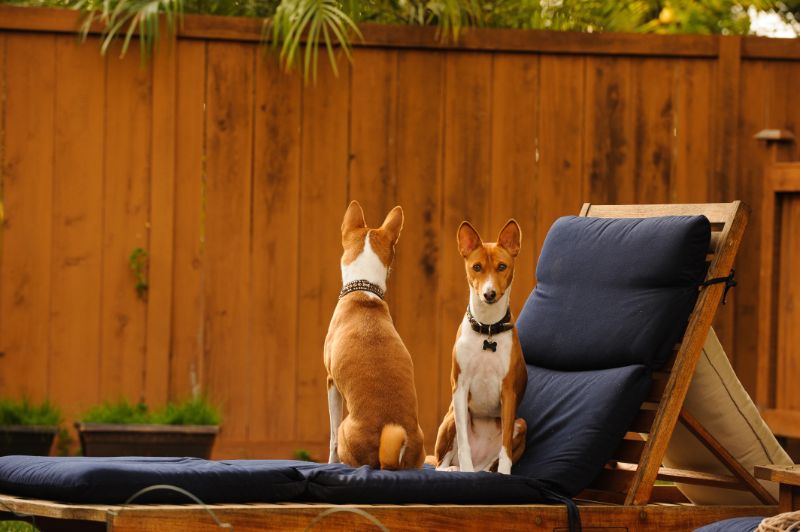
Additional Aspects to Consider for Your Dog’s Safety
Adding a Fence Topper for Extra Security
If you have a particularly determined jumper or climber, you might want to consider adding a fence topper. This can be a horizontal bar that extends inward from the top of the fence, creating an additional barrier that’s difficult for dogs to navigate.
For dogs with exceptional jumping skills or those living in areas with potential wildlife threats, additional height extensions or coyote rollers prove to be invaluable modifications to your dog-friendly fence. Height extensions involve adding extra fencing materials on top of the existing fence to create an obstacle that surpasses your dog’s jumping abilities.
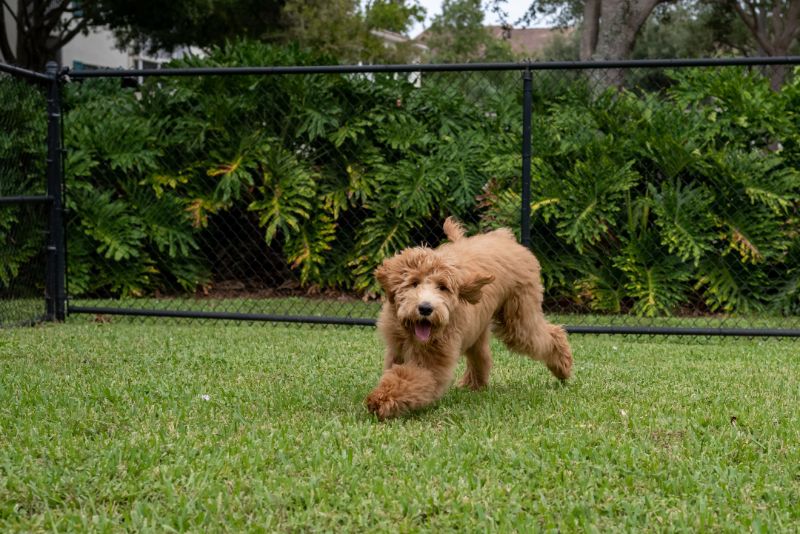
Maintaining Balance: Safety and Freedom
Keeping it Fun and Safe
Choosing a fence based on your dog’s behavior doesn’t mean creating a prison for your pooch. It’s about finding a balance that keeps them safe and contained, yet also allows them the freedom to enjoy their outdoor time. Including elements like dog-friendly landscaping, toys, and comfortable resting places can make your yard a canine paradise.
The Final Word: Professional Advice is Key
While this guide provides a thorough overview, it’s always advisable to consult with a pet behaviorist and a fencing professional when making your final decision. They can provide personalized advice based on the specific behavior and needs of your dog.
In conclusion, understanding your dog’s behavior is crucial in selecting the right fence. With the right balance of safety and freedom, your dog will have a fun and secure outdoor space to enjoy.
FAQs
Q: How high should my fence be to prevent my dog from jumping over? A: The fence height depends on your dog’s size and jumping ability. For medium-sized dogs, a fence height of at least 4 to 5 feet is recommended. For larger breeds or agile jumpers, consider a fence height of 6 to 8 feet.
Q: Will an electric fence harm my dog? A: When used correctly, electric fences do not harm dogs. These systems emit a mild static correction, similar to a gentle static shock, which is designed to get their attention and discourage them from crossing the boundary.
Q: Are invisible electric fences effective for all dogs? A: Invisible electric fences are more suitable for dogs that have already undergone basic obedience training and have a good understanding of boundaries. For puppies or dogs with behavioral issues, a physical fence is usually recommended.
Q: Can I train my dog to stop digging under the fence? A: Yes, you can train your dog to stop digging under the fence. Positive reinforcement techniques and providing alternative digging areas, such as sandboxes, can help redirect their digging behavior.
Q: Is it necessary to consult a professional dog trainer when selecting a fence? A: While consulting a professional dog trainer is not mandatory, it can be beneficial, especially if you have a challenging or unique situation. They can provide expert advice tailored to your dog’s specific needs, ensuring you make the best fence selection.
Q: Can my dog learn to respect boundaries with an invisible electric fence? A: With proper training, dogs can learn to respect the boundaries set by an invisible electric fence. However, it’s important to note that these fences are not foolproof, and some determined dogs may still try to breach the boundary.
Looking for a reliable contractor to build your dog-friendly fence in the greater Seattle area?
Look no further than Sky Fence Company! With our expertise in fencing and a commitment to quality, we’re the perfect choice to ensure the safety and happiness of your furry friend. From escape artists to social butterflies, we’ve got the right solutions for every dog’s unique needs. Contact Sky Fence Company today and let us create a secure and beautiful space for your dog to roam freely. Your pup will thank you for it!

